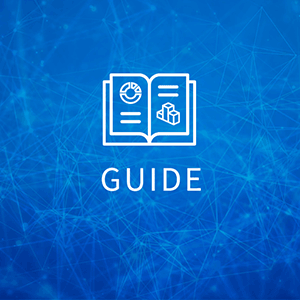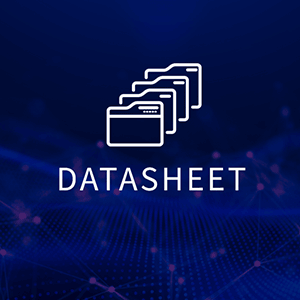What is CMDB & CMDB Benefits
Configuration management database (CMDB) traditionally refers to a database, or data warehouse, that stores hardware and software asset information, as well as relevant specifics on those assets, to understand both physical and logical technology relationships, plan infrastructure and support initiatives such as IT service management (ITSM).
CMDB is a term historically laden with untrustworthiness and failure. No offense to CMDB, but anecdotally, every time the term comes up, the underlying context is in how it didn’t live up to its delivery goals. Part of that is due to the manual effort required to keep a CMDB clean and curated, due in part to the changing nature of what a CMDB is—it needs to have purpose, not just to be a bucket stuffed with random technology data hoping for a use case.
When Forrester Research refers to digital pipeline information, they’re talking about where CMDB is going; it’s becoming more than a warehouse for IT projects and it’s already expanded beyond traditional IT service management (ITSM) usage.
As Gartner points out, with hybrid digital infrastructure management (HDIM), managing technology is complex. The world according to IT is only going to expand and evolve into new technologies and processes for data, so why can’t CMDB evolve with them?
Technology organizations are focusing on digital transformation
According to Flexera’s 2021 State of Tech Spend Report, digital transformation, cyber security and cloud are the top initiatives for tech organizations in 2021. And that makes perfect sense—the world has adapted, from a technology perspective, to working in a remote landscape during the pandemic and with that comes the vulnerabilities associated with a remote workforce. Now that the genie is out of the bottle per se, it’s likely to continue that many organizations will work from home or provide a hybrid office/home environment. That means the same risks with remote workers added to the change in infrastructure planning needed to also accommodate in-office technology.
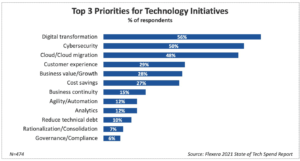
How IT teams use data overall is changing and this affects what would be traditionally used in a CMDB. Now we’re looking at asset managers, enterprise architects, information security and cyber security, ITSM and even cloud architects using asset inventory data—for example, lifecycle information—to make decisions about how to update applications or infrastructure that feeds into various business services, or about what servers they can migrate to the cloud. The types of assets have expanded to span across on-premises, SaaS and cloud and include things like containers and hybrid cloud instances. Organizations must be more thoughtful about what they put into a CMDB to avoid overcomplicating and overstuffing it with anything and everything.
Business service management is powered by clean data from CMDB
The term CMDB may be outdated, but it’s a relevant model that can be expanded into today’s use cases. Think about all the initiatives you have in your organization today—financial management, supply chain and procurement, service management, security and others. They all rely on clean and trustworthy data.
As we see below, the major challenges to IT decision making revolve around good-quality data and how long it takes to make a decision—it takes longer to make a decision and longer to implement it if the data it’s based on isn’t reliable. And in many cases, decisions made off of bad data are often the wrong decision. Are you sourcing that data from several places or from a single repository? If the latter, are you qualifying that data before pulling it into your ecosystem of business tools?
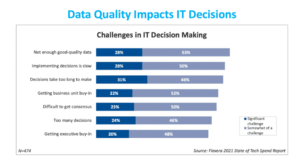
These are key questions organizations need to define, and both answers lead to the use of a CMDB. Whether those services are tools you pay for (e.g., customer relationship management or human resources), applications you provide to your customer base (e.g., mobile app or community) or internally built, they rely on a complex network of applications and servers running in your organization. It’s up to IT to make sure those pieces (apps and servers) converse accordingly, and if you make changes to any one of them it doesn’t disrupt delivery of any one of those services.
Technology value optimization (TVO) also starts with clean data
Coming back to your ecosystem, you’ve already invested in your infrastructure and organizational technology. In fact, Gartner expects 20 percent of enterprises to use HDIM (read: technology value optimization) tools to optimize workload placement by 2022. To that end, Flexera’s 2023 State of the Cloud Report respondents stated that more than half of respondents’ workloads and data are in the public cloud will more expected on both fronts next year.
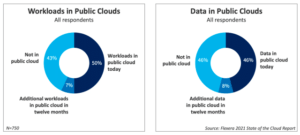
You already know your environment is complex and your data even more so. Whether you’re trying to mitigate risks, manage audits, rationalize your application sprawl or myriad other business initiatives, the foundation starts with reliable data on which to base those decisions.
Again, this brings up the CMDB. It’s not dead, because IT data will always be necessary to make informed business decisions. TVO maximizes the business value of your current technology investments—and it’s only possible if you can discover and rely on your tech information.
Deliver ROI with informed processes
At this point, we’ve hit the main issue with CMDBs and data projects as a whole—the data is varied, sprawling and unwieldy. That’s why many of those projects referenced earlier fail. The data doesn’t have direction and your planned use of it isn’t defined. OK, but you have all these tools in your organization (e.g., ServiceNow, Planview, Tanium, BMC, etc.), and you know they need reliable data, and that the data they individually discover will look different for each application. So where are you supposed to source this to keep it consistent?
IT Visibility
The business promise of your IT is huge. But it takes a complete, up-to-date view of your hybrid environment to make the most of it.
Call it a digital pipeline. Call it information management. Call it a CMDB. No matter what you call it, it’s now more relevant than ever, and though it needs care and a bit of maintenance, it’s not as unwieldy as you may think, especially with the right partner.
See how you can illuminate your IT environment; learn more about the importance of a clean and curated CMDB, and how to avoid the missteps of the past by planning for the ever-changing future.




